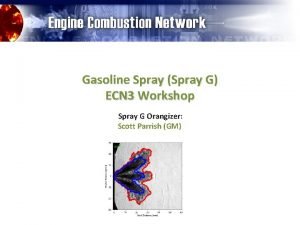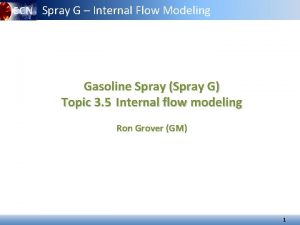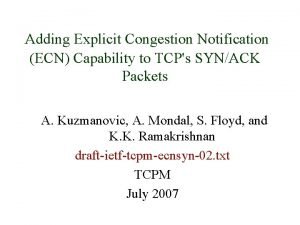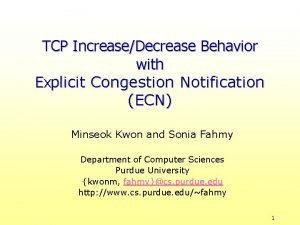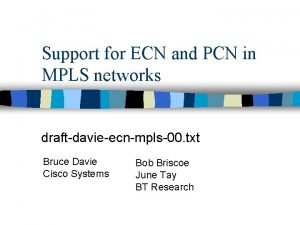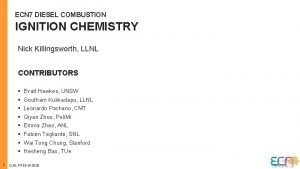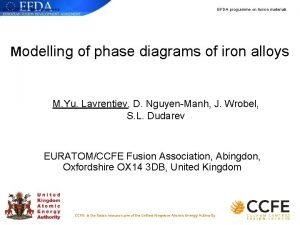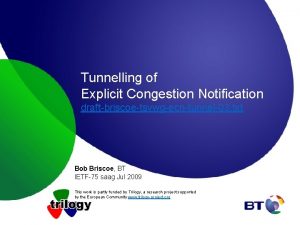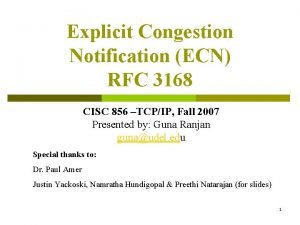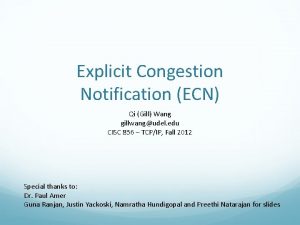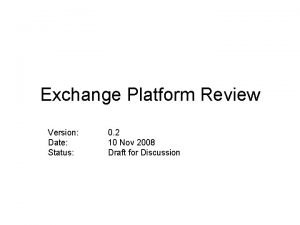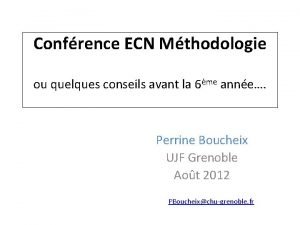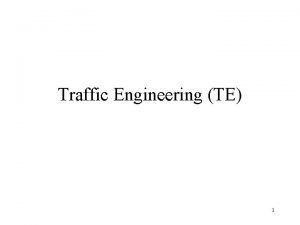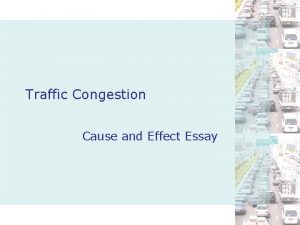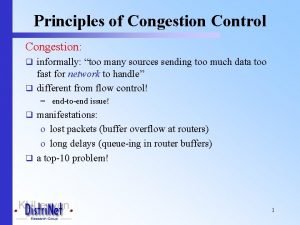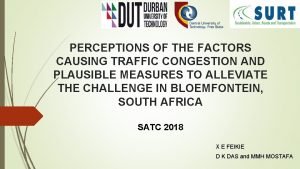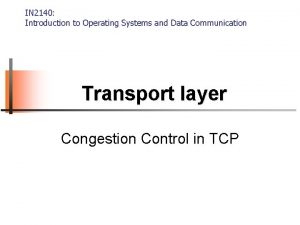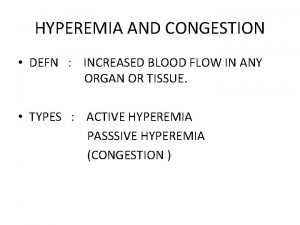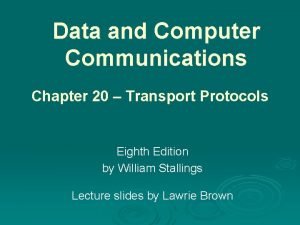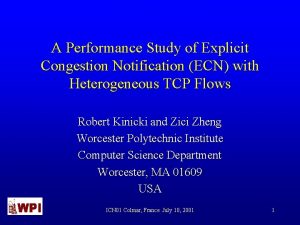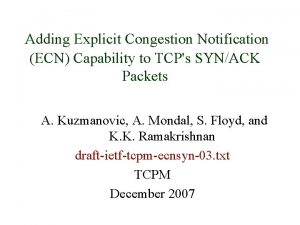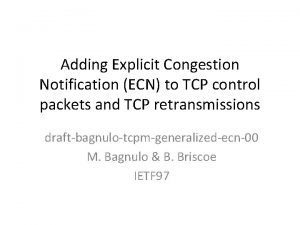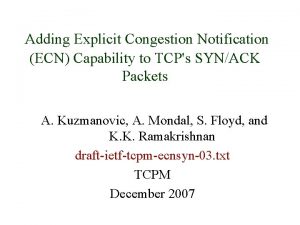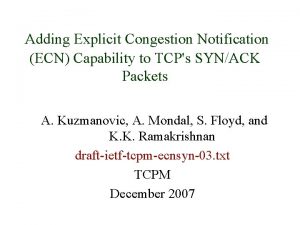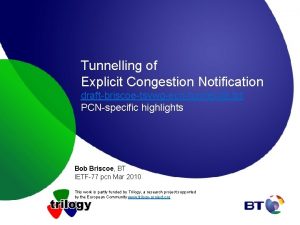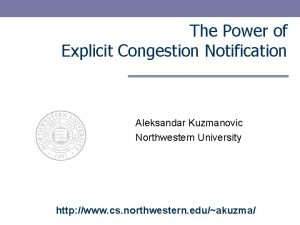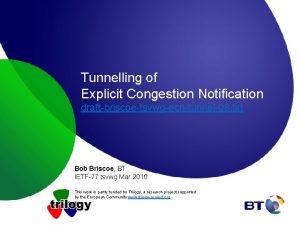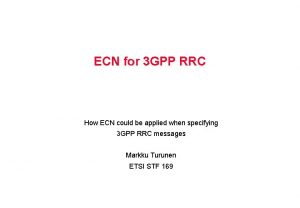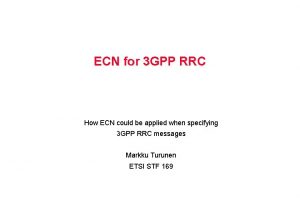A Performance Study of Explicit Congestion Notification ECN


























- Slides: 26

A Performance Study of Explicit Congestion Notification (ECN) with Heterogeneous TCP Flows Robert Kinicki and Zici Zheng Worcester Polytechnic Institute Computer Science Department Worcester, MA 01609 USA ICN 01 Colmar, France July 10, 2001 1

Outline • Motivation for Studying ECN • Performance Metrics • Random Early Detection (RED) and ECN Routers • Simulation Topology and Experimental Procedures • Results and Analysis • Conclusions ICN 01 Colmar, France July 10, 2001 2

Motivation for Studying ECN • Congestion is still an Internet problem. • Researchers advocate Active Queue Management (AQM) techniques such as RED and ECN for congestion control. • RED has been shown to be difficult to tune. • RED can be unfair to heterogeneous flows. ICN 01 Colmar, France July 10, 2001 3

Motivation for Studying ECN • Researchers believe ECN is better after a few RED versus ECN comparison studies. • The differences between RED and ECN behavior is not well understood. • Is ECN also unfair to heterogeneous flows? • What happens when there are many flows? • Can ECN be adapted to perform better? ICN 01 Colmar, France July 10, 2001 4

Performance Metrics • throughput (Mbps) - the aggregate rate of packets generated by all sources. • goodput (Mbps) - the rate at which packets arrive at the receiver. Goodput differs from throughput in that retransmissions are excluded from goodput. • delay (sec) - the time required to transmit a packet from source node to receiver node. ICN 01 Colmar, France July 10, 2001 5

Performance Metrics • Jain’s fairness – For any given set of user throughputs (x 1, x 2, …xn ), the fairness index to the set is defined: f(x 1, x 2, …, xn) = • max-min fairness – A flow rate x is max-min fair if any rate x cannot be increased without decreasing some y which is smaller than or equal to x. To satisfy the min-max fairness criteria, the smallest throughput rate must be as large as possible. • “visual” max-min fairness – the visual gap between the smallest and the largest goodput ICN 01 Colmar, France July 10, 2001 6

RED Routers • Random Early Detection (RED) detects congestion “early” by maintaining an exponentially-weighted average queue size. • RED probabilistically drops packets before the queue overflows to signal congestion to TCP sources. • RED attempts to avoid global synchronization and bursty packet drops. ICN 01 Colmar, France July 10, 2001 7

ECN Routers • Explicit Congestion Notification (ECN) is a RED extension that marks packets to signal congestion. • ECN must be supported by both TCP senders and receivers. • ECN-compliant TCP senders initiate their congestion avoidance algorithm after receiving marked ACK packets from the TCP receiver. • Packets from non-ECN flows are treated by the RED mechanism in the ECN router. ICN 01 Colmar, France July 10, 2001 8

RED and ECN Router Parameters • avg : average queue size avg = (1 -wq) * avg + wq * instantaneous queue size • wq : weighting factor 0. 001 <= wq <= 0. 004 • min_th : average queue length threshold for triggering probabilistic drops/marks. • max_th : average queue length threshold for triggering forced drops • max_p : maximum dropping/marking probability pb = max_p * (avg – min_th) / (max_th – min_th) pa = pb / (1 – count * pb) • buffer_size: the size of the router queue in packets ICN 01 Colmar, France July 10, 2001 9

RED/ECN Router Mechanism 1 Dropping/Marking Probability max_p 0 Min-threshold Max-threshold Queue Size Average Queue Length ICN 01 Colmar, France July 10, 2001 10

Simulation Topology and Experimental Procedures • three sets of heterogeneous flows – Fragile flows, Robust flows, Average flows – flows delineated by distance from congested router • two ECN variants – ECN: ECN with Drop after max_th – ECNM: ECN with Mark after max_th ICN 01 Colmar, France July 10, 2001 11

Simulation Topology 600 Mbps Router F 1 . . . Fm 10 mbps, 5 ms 145 ms A 1 5. ms . . R 1 : Source . . Am Rm : Sink RTTs: (300 ms, 100 ms, 20 ms) ICN 01 Colmar, France July 10, 2001 12

Experimental Procedures and Parameter Settings • • • 100 second ns-2 simulations n flows divided equally among three flow types (n = 3 m) input demand, i. e, aggregate flow capacity fixed at 600 Mbps • staggered start of half the flows (0 sec, 2 sec) • fixed RED/ECN and TCP parameters for all runs – – wq = 0. 001 min_th = 5 buffer_size = 50 packets TCP max_window_size = 30 packets ICN 01 Colmar, France July 10, 2001 13

Figure 2: RED and ECN Goodput min_th = 5, max_th = 30 ICN 01 Colmar, France July 10, 2001 14

Figure 3: RED and ECN Delay min_th = 5, max_th =30, max_p =0. 5 ICN 01 Colmar, France July 10, 2001 15

Figure 4: Goodput with 30 flows min_th = 5 ICN 01 Colmar, France July 10, 2001 16

Figure 5: Goodput with 120 flows min_th = 5 ICN 01 Colmar, France July 10, 2001 17

Figure 6: RED and ECN Fairness min_th = 5, max_th = 30 ICN 01 Colmar, France July 10, 2001 18

Figure 7: Goodput Distribution with 30 flows min_th = 5, max_th = 30, max_p = 0. 2 ICN 01 Colmar, France July 10, 2001 19

Figure 8: Goodput Distribution with 30 flows min_th = 5, max_th = 30, max_p = 0. 8 ICN 01 Colmar, France July 10, 2001 20

Figure 9: Goodput Distribution with 120 flows min_th = 5, max_th = 30, max_p = 0. 8 ICN 01 Colmar, France July 10, 2001 21

Figure 10: Throughput Distribution with 120 flows min_th = 5, max_th = 30, max_p = 0. 8 ICN 01 Colmar, France July 10, 2001 22

Figure 11: ECN and ECNM Goodput with 120 flows min_th = 5 ICN 01 Colmar, France July 10, 2001 23

Conclusions • ECN provides higher goodput than RED. • Both RED and ECN are unfair to heterogeneous flows. ECN is fairer in some situations. • ECN performs better with a more aggressive max_p setting. This is more pronounced when the number of flows generating the demand is high. ICN 01 Colmar, France July 10, 2001 24

Conclusions • For fixed demand, as the number of flows increase the performance of both RED and ECN decrease. – This may be due to buffer contention at the router and flow lockout. • When there are many flows, increasing max_th improves ECN goodput. ICN 01 Colmar, France July 10, 2001 25

Conclusions • An adaptive version of ECN that varies max_p and max_th appears to be promising. • An adaptive ECN mechanism that varies max_p with flow type should significantly improve fairness. ICN 01 Colmar, France July 10, 2001 26
 Circumciliary congestion and conjunctival congestion
Circumciliary congestion and conjunctival congestion Ecn spray g
Ecn spray g Ecn spray g
Ecn spray g Ecncapability
Ecncapability Ecn
Ecn Ecn pcn
Ecn pcn Ecn
Ecn Ecn
Ecn Not ecn capable transport
Not ecn capable transport Syn, ecn, cwr
Syn, ecn, cwr Gill wang
Gill wang Lossy network
Lossy network Ecn exam france
Ecn exam france Qi ecn
Qi ecn Inet ecn
Inet ecn Pmz ecn
Pmz ecn Network congestion causes
Network congestion causes Traffic essay
Traffic essay Principles of congestion control
Principles of congestion control Conclusion of traffic congestion
Conclusion of traffic congestion In2140
In2140 Difference between hyperemia and congestion
Difference between hyperemia and congestion Tcp congestion control
Tcp congestion control Traffic throttling and load shedding
Traffic throttling and load shedding Congestion control in virtual circuit
Congestion control in virtual circuit Congestion control principles
Congestion control principles Eneritis
Eneritis

